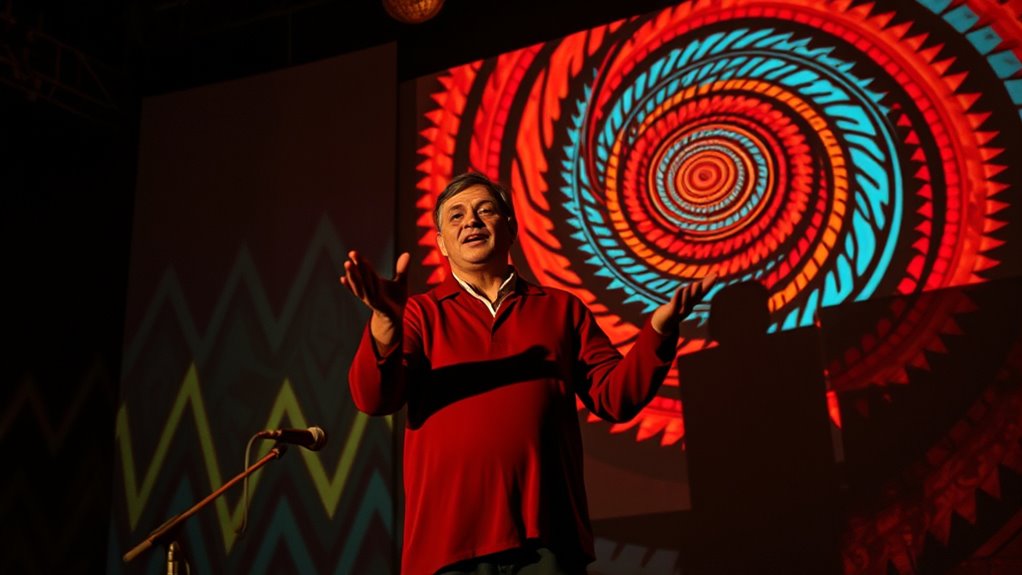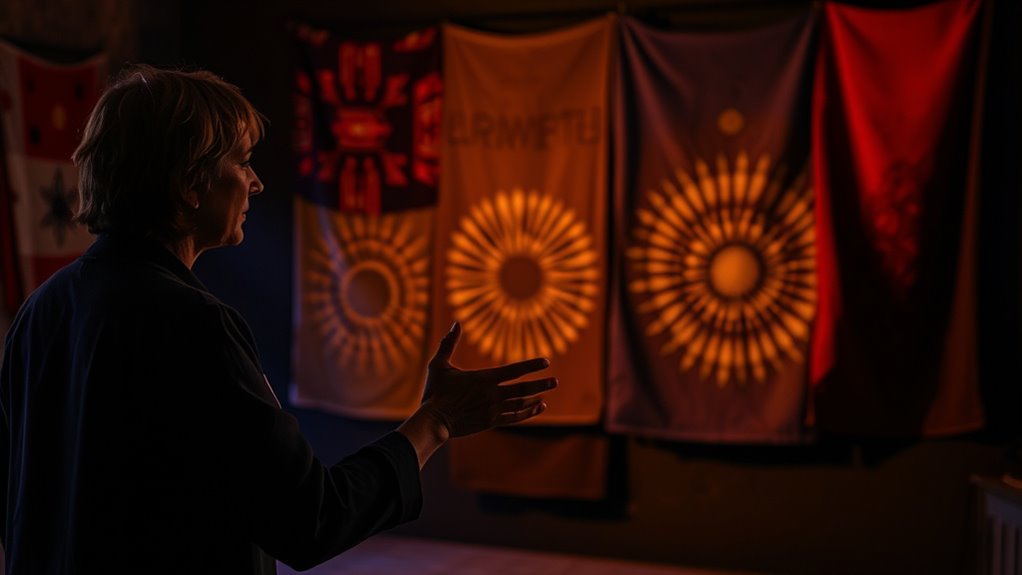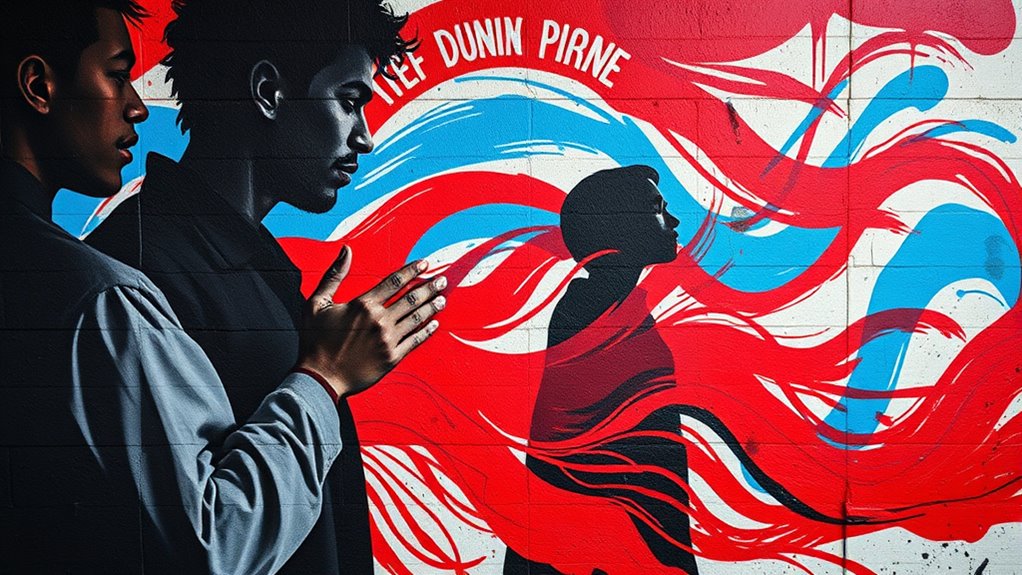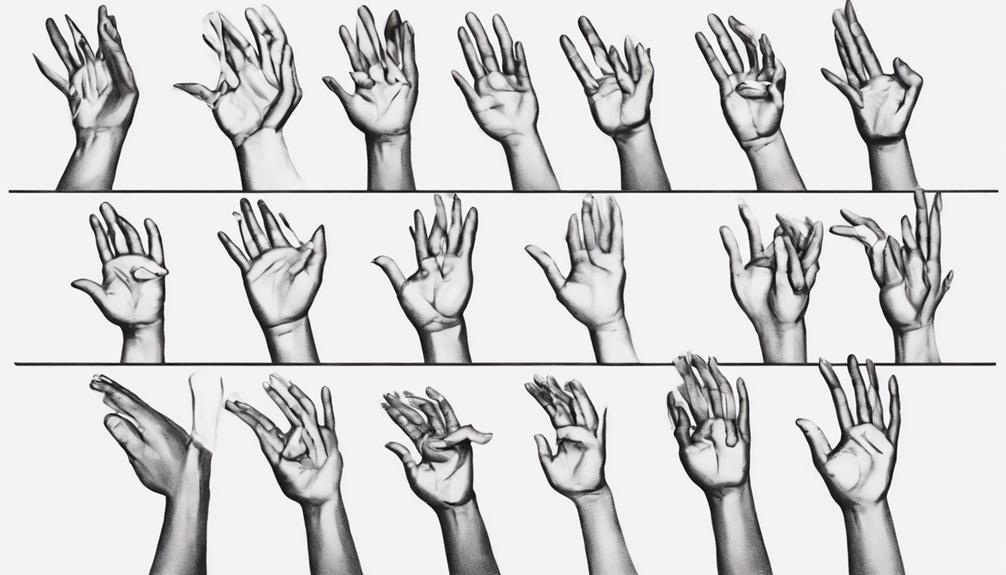Deaf poetics turns visual gestures, facial expressions, and spatial arrangements into a vibrant art form that embodies rhythm and rhyme beyond sound. You’ll notice how movement and gestures create a dynamic flow, while sign language conveys complex emotions and ideas through visual storytelling. This art celebrates cultural identity, blending tradition with innovation. If you keep exploring, you’ll discover how artists harness these visual tools to craft powerful, poetic expressions.
Key Takeaways
- Deaf poetics utilizes movement, facial expressions, and spatial arrangements as visual tools for storytelling and emotional expression.
- It transforms sign language into a poetic medium, emphasizing rhythm, gesture symbolism, and visual symbolism for artistic depth.
- Rhythmic devices include gestures, body shifts, and spatial layouts that guide viewer perception and evoke emotional responses.
- Artists like Clayton Valli and Ella Mae Lentz pioneered visual storytelling, blending intricate gestures with expressive choreography.
- Future innovations involve digital, interactive, and immersive technologies expanding accessibility and creative possibilities in Deaf poetics.
The Origins and Cultural Significance of Deaf Poetics

Deaf poetics originates from the rich cultural and linguistic traditions of Deaf communities, who have long used visual and gestural forms of expression to communicate and tell stories. These cultural roots run deep, shaping a unique artistic language that emphasizes movement, facial expressions, and spatial awareness. As Deaf communities evolved, so did their artistic practices, blending storytelling with expressive gestures that convey complex emotions and ideas. This artistic evolution reflects a desire to preserve cultural identity while creating a dynamic form of expression. Deaf poetics isn’t just about language; it’s a celebration of visual storytelling that honors tradition and innovation alike. Additionally, color symbolism plays a significant role in enhancing the emotional depth and meaning within Deaf poetics performances. By understanding these origins, you appreciate how Deaf poetics continues to grow, enriching the cultural landscape with its powerful visual rhythm.
Visual Elements That Define Deaf Poetry

The visual elements that define Deaf poetry are central to its expressive power, transforming movement, facial expressions, and spatial arrangements into meaningful storytelling tools. Color symbolism plays a vital role, conveying emotions and themes without words—bright reds for passion, cool blues for calm. You use these colors intentionally to evoke specific feelings and deepen the poem’s impact. Text layering is another key element, where words, symbols, and images overlap or are arranged in complex patterns to add depth and multiple meanings. This technique invites you to interpret the visual flow and relationships between elements, enhancing the rhythm and rhyme of the piece. Incorporating visual symbolism can further amplify the emotional resonance and thematic clarity of Deaf poetry. Together, these visual elements create a vibrant, dynamic canvas that captures the essence of Deaf poetics beyond spoken language.
Sign Language as a Poetic Medium

Sign language transforms visual storytelling into a poetic form that goes beyond spoken word. It is a vibrant medium for poetic expression, where hand gestures, facial expressions, and body movements create rhythm and meaning. Each sign carries weight, rhythm, and emotion, allowing you to craft verses that resonate deeply. Unlike written or spoken poetry, sign language relies on visual cues to convey nuance and tone, making the rhythm palpable and immediate. You can manipulate speed, intensity, and spacing of signs to produce visual rhyme and meter. This fluid, expressive language turns physical movement into poetry, engaging viewers on a sensory level. By embracing sign language as a poetic medium, you tap into a rich tradition of visual rhythm that elevates deaf poetics to an art form all its own. Incorporating Glycolic Acid Benefits into skincare routines can also enhance the visual clarity of the skin, complementing the expressive power of visual poetry.
Spatial Arrangements and Their Impact on Meaning

Your spatial layout directs the viewer’s attention and shapes the meaning of the poem. Line placement guides the flow of movement and emphasis, creating rhythm and focus. Visual gaps and silence become powerful tools, emphasizing pauses and unspoken messages that deepen the overall impact. Incorporating visual cues can enhance the clarity and emotional resonance of the poetic message.
Spatial Layout and Emphasis
Spatial layout in deaf poetics plays a crucial role in shaping how meaning is conveyed and understood. It guides your focus through spatial emphasis, creating a visual hierarchy that highlights key ideas. The arrangement of signs and symbols influences rhythm, drawing attention to specific elements and shaping emotional impact. By strategically positioning visual elements, you control the flow and emphasis, making the message more powerful. Consider this table, which demonstrates how different arrangements can alter perception:
| Element 1 | Element 2 | Element 3 |
|---|---|---|
| Emphasized | Neutral | Subtle |
| Hierarchy | Flow | Focus |
| Impact | Rhythm | Meaning |
| Balance | Tension | Clarity |
Your choices in spatial layout directly affect how viewers interpret and engage with the poetics. Additionally, understanding the visual hierarchy concept helps optimize the arrangement for clearer communication and stronger emotional resonance.
Line Placement and Flow
Line placement and flow in deaf poetics directly influence how viewers move through a message, guiding their attention and emotional response. You control the spatial dynamics by carefully arranging lines to create a rhythm that naturally directs the eye. Strategic visual sequencing emphasizes key ideas, making certain lines stand out or flow seamlessly into the next. When you vary line length or position, you manipulate pacing, encouraging viewers to linger or move quickly. This dynamic arrangement shapes meaning beyond words, fostering an intuitive understanding. Effective line placement transforms static signs into a visual dance, engaging viewers on a deeper level. Your mastery of spatial arrangements ensures that every line contributes to the poem’s rhythm, rhythmically guiding viewers through its emotional and conceptual landscape. Incorporating principles of visual design can further enhance the harmony and impact of the poem’s flow.
Visual Gaps and Silence
How do visual gaps and silence shape the meaning of a deaf poem? These elements create visual silence, emphasizing pauses that guide your interpretation. Rhythmic gaps disrupt continuous flow, allowing your eye to process each part intentionally. When a poet leaves space between images or words, it signals a shift or pause, heightening emotional impact. These spatial arrangements generate a rhythm beyond spoken sound, making silence itself expressive. Visual silence invites you to reflect on what’s omitted, adding layers of meaning. The strategic placement of gaps transforms the poem into a visual rhythm, where silence becomes an active element. By manipulating these rhythmic gaps, poets craft a dynamic interplay between presence and absence, guiding your engagement and deepening the emotional resonance. Additionally, understanding Vetted – Grobal World concepts can inspire new approaches to spatial arrangement and silence in visual poetry.
Movement and Gesture as Rhythmic Devices

Movement and gesture serve as essential rhythmic devices in deaf poetics, enabling poets to express timing and emotion beyond spoken words. Your movement vocabulary—specific gestures and body shifts—creates a visual cadence that guides viewers through the poem’s flow. Each gesture carries gesture symbolism, representing ideas, feelings, or narrative moments, giving deeper layers of meaning. By varying the speed, scope, and intensity of your movements, you establish a rhythmic pulse that complements the visual structure. This physical rhythm can evoke anticipation, tension, or release, engaging your audience on a visceral level. Your deliberate use of movement and gesture transforms silent expression into a dynamic poetic language, where timing and emotion are conveyed through spatial and kinesthetic cues that resonate beyond words. Incorporating self-watering plant pots as an analogy, the consistent flow of movement sustains the rhythm much like a reservoir maintains moisture, providing stability and continuity in poetic expression.
Comparing Deaf and Hearing Poetic Forms

Deaf and hearing poetic forms differ markedly in their methods of conveying rhythm and meaning. Hearing poetry often relies on auditory symbolism, where sound patterns, rhyme, and meter evoke emotions and images through lyrical storytelling. In contrast, Deaf poetry emphasizes visual rhythm and movement, using gestures and spatial arrangement to express meaning. While hearing poetry taps into sound-based cues, Deaf poetry communicates through visual cues that engage the audience’s senses differently. Additionally, practicing stillness can deepen the observer’s awareness of these visual and physical expressions, enriching their appreciation of the art forms.
Notable Artists and Works in Deaf Poetics

Have you ever encountered the powerful works of artists who harness visual and physical expression to craft poetry? Artists like Clayton Valli and Ella Mae Lentz revolutionized Deaf poetics through their innovative use of visual storytelling. Valli’s signed poems combine intricate hand movements with rhythmic patterns that evoke emotion and deepen connection. Lentz’s performances blend expressive gestures with compelling narratives, creating works that resonate emotionally with viewers. These artists demonstrate how physicality and visual cues can communicate complex ideas and feelings beyond words. Their contributions highlight the unique potential of Deaf poetics to forge emotional resonance through visual rhythm and rhyme. By pushing boundaries, these creators show how Deaf artistry can inspire and challenge conventional poetic forms, revealing a rich landscape of expressive possibilities. Visual storytelling techniques play a crucial role in enhancing the emotional impact of Deaf poetry.
Challenges and Opportunities in Deaf Poetic Expression

While Deaf poets have expanded the boundaries of poetic expression through visual and physical means, they also face significant challenges. One major obstacle is relying on sensory perception beyond sound, which can limit traditional poetic forms rooted in auditory cues. You might find it difficult to convey emotional resonance without voice or tone, requiring innovative methods to evoke feelings visually or physically. Additionally, audiences unfamiliar with Deaf culture may struggle to interpret the layered meanings behind gestures, expressions, or visual rhythms. However, these challenges present opportunities too. You can develop unique poetic languages that emphasize vivid visuals, tactile sensations, and powerful emotional cues. By embracing these differences, you create a rich, inclusive space where sensory perception becomes a profound tool for artistic expression.
The Future of Visual Rhythm and Rhyme in Artistic Practice

Technological innovations are reshaping how artists create and experience visual rhythm and rhyme. You’ll see emerging styles that blend traditional and digital techniques, opening new avenues for expression. This evolving landscape invites you to contemplate how these changes will influence future artistic practices.
Technological Innovations Transforming Art
Advancements in digital technology are reshaping how artists create and experience visual rhythm and rhyme. You can now leverage tools like digital storytelling to craft immersive narratives that blend visual and rhythmic elements seamlessly. Virtual exhibitions allow you to showcase your work globally, breaking physical barriers and reaching wider audiences. These innovations enable interactive experiences, where viewers engage with art dynamically. Consider this table highlighting key technological trends:
| Technology | Impact on Visual Rhythm | Audience Engagement |
|---|---|---|
| Digital storytelling | Enhances narrative flow | Deepens emotional connection |
| Virtual exhibitions | Expands accessibility | Promotes broader exposure |
| Augmented reality | Adds interactive layers | Creates immersive environments |
| AI-generated art | Innovates rhythmic patterns | Personalizes viewer experience |
These tools push the boundaries of traditional art, transforming how you create and share visual rhythm and rhyme.
Emerging Styles and Expressions
As artists continue to experiment with new mediums and tools, emerging styles are redefining the landscape of visual rhythm and rhyme. You’ll see a surge of innovative approaches that blend cultural identity with artistic innovation, creating fresh expressions.
- Hybrid Forms – Combining traditional Deaf visual language with digital art to forge unique rhythmic patterns.
- Interactive Pieces – Using technology to invite viewers into immersive, rhythm-driven experiences.
- Cultural Fusion – Integrating diverse cultural symbols to deepen meaning and celebrate identity.
- Abstract Rhythms – Moving beyond literal signs to explore emotional and visceral visual rhyme.
These styles push boundaries, making visual rhythm and rhyme more dynamic, inclusive, and reflective of evolving cultural identities.
Frequently Asked Questions
How Do Deaf Poets Incorporate Cultural Identity Into Their Work?
You can see how deaf poets incorporate cultural identity into their work by using sign language as a powerful storytelling tool. They blend visual rhythms and rhymes to express shared experiences and cultural stories, creating a unique poetic voice. Through expressive gestures and signs, they celebrate their heritage, making their work not just art but a vibrant reflection of their community’s history and identity.
What Role Does Technology Play in Modern Deaf Poetic Expression?
Imagine technology transforming your voice into a symphony of signs—sign language software and digital performativity make this possible. You harness these tools to craft deaf poetry that’s vibrant and dynamic, breaking barriers like never before. Technology isn’t just a tool; it’s your amplifier, letting your visual rhythm and rhyme reach hearts worldwide, creating a powerful, modern language that celebrates deaf culture and innovation in ways you never thought possible.
How Is Deaf Poetics Received in Mainstream Literary Communities?
You might find that deaf poetics receives mixed audience reception; some celebrate its innovative visual rhythm, while others overlook it. Critical analysis increasingly recognizes its unique contribution to contemporary literature, emphasizing its use of visual elements and rhythm. As you explore, you’ll see that mainstream literary communities are gradually embracing deaf poetics, appreciating its different approach to storytelling and poetic expression, enriching the broader literary landscape.
Can Deaf Poetry Be Adapted for International Audiences Across Languages?
You wonder if deaf poetry can reach international audiences across languages. While language barriers and cultural translation pose challenges, you can adapt deaf poetry by emphasizing visual elements like rhythm and rhyme that transcend spoken language. By collaborating with native speakers and cultural experts, you guarantee the essence remains authentic. This way, your poetry connects globally, resonating through visual storytelling and universal themes, despite linguistic differences.
What Ethical Considerations Arise in Representing Deaf Experiences Through Poetry?
You wonder about the ethical considerations in portraying deaf experiences through poetry. It’s essential to prioritize authentic representation, ensuring you respect the diversity within deaf culture. Cultural sensitivity is key—avoid stereotypes or oversimplifications that could mislead or offend. As you craft your poetry, remember that honoring genuine deaf voices fosters understanding and trust, making your work a powerful bridge rather than a misstep into misrepresentation.
Conclusion
As you explore deaf poetics, you embrace a rich tapestry of visual rhythm and expressive nuance that gently redefines traditional notions of poetry. This art form invites you to see language as a dance of gestures, space, and movement, subtly inspiring new ways of understanding and connecting. In appreciating its delicate beauty, you become part of a evolving dialogue that honors silent voices and unspoken depths, gently shaping the future of artistic expression.











